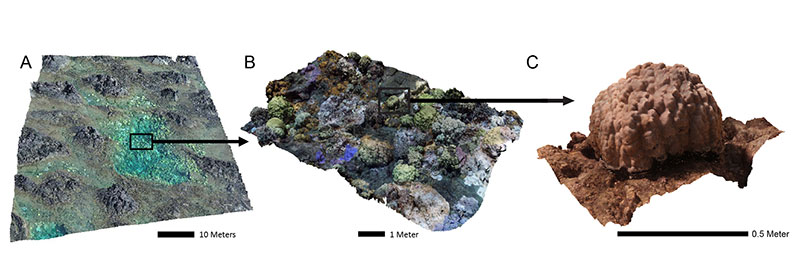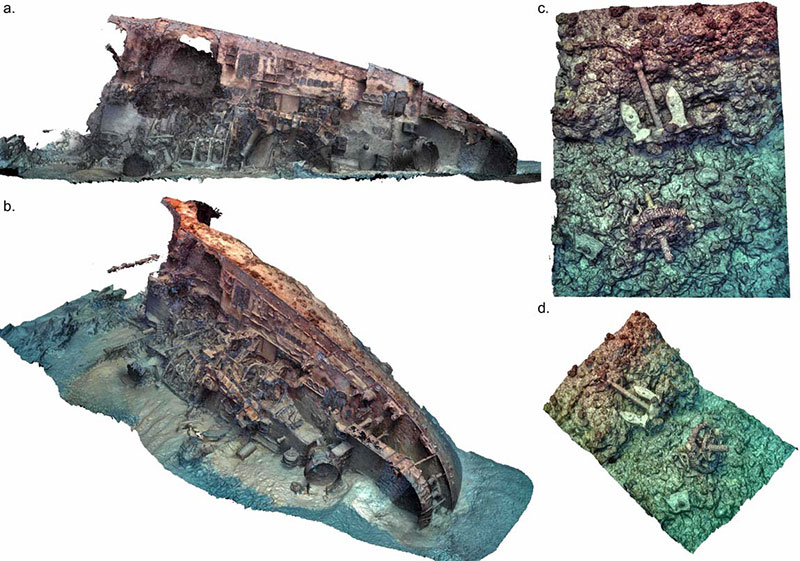
by John H.R. Burns, Ph.D., University of Hawai’i Hilo
Coral reefs are architecturally complex three-dimensional (3D) habitats, whose structure is intrinsically linked to the ecosystem biodiversity, productivity, and function. Unfortunately, the field of coral ecology has been limited to using two-dimensional (2D) planar survey techniques for studying coral reef composition and structure. Although this conventional approach is simple to implement, it fails to capture or quantify the intricate structural complexity of corals that influences habitat facilitation and biodiversity. A 3D approach enables accurate measurements of architectural complexity, topography, rugosity, volume, and other structural characteristics that significantly affect biodiversity and abundance of reef organisms.

Figure 1: Example of 3D reef reconstructions at multiple scales. (a) Oblique view of large area of reef substrate surveyed with drone imagery showing; (b) oblique view of a 3D model of coral colonies (millimeter-resolution); and (c) an individual colony (millimeter-resolution) reconstructed from this same location surveyed with single lens cameras. Image courtesy of the University of Hawai’i Hilo. Download larger version (936 KB).
We have spent several years developing an innovative approach that combines Structure-from-Motion (SfM) photogrammetry with geospatial software to create high-resolution 3D maps of coral reefs. This approach involves collecting hundreds of overlapping images of our study sites and processing the images using cutting-edge technology to reconstruct the reefs into 3D models (Figure 1). These models can be used to determine how the structure of live coral provides habitats for fish and various reef creatures and what happens to the overall abundance and biodiversity of reef organisms when corals are impacted by disturbances.
Utilizing a 3D mapping approach dramatically improves our ability to monitor the health and mortality of corals. The degradation and recovery of corals has only been investigated with 2D assessments of coral cover; however, this metric fails to capture changes occurring in the architectural complexity of reefs than may underpin a suite of important ecosystem functions including wave energy dissipation, nutrient recycling, and the abundance, diversity, and trophic structure of fish and invertebrates. For the first time, we will use this 3D methodology to examine coral reefs at Peleliu.
Impacts to corals from the World War II (WWII) invasion blasting have never been investigated. We will map coral reef plots in areas affected as well as those unaffected by the invasion blasting and statistically compare coral composition and habitat structure among these sites. This work will help us identify if and how the blasting may have affected coral community structure and how it may be altering the ecology of these systems. The resulting models will also provide us with a useful baseline for assessing reef health in future years.

Figure 2: Textured 3D models of archeological wrecks surveyed in the Northwestern Hawaiian Islands. SfM photogrammetry techniques were used to model large stern sections of the USNS Mission San Miguel (a,b) and additional ship components on the adjacent coral reef (c,d). Figure adapted from Price et al. 2016. Download larger version (506 KB).
The same method for characterizing the corals will be applied to the documentation of the WWII remains found on the reef (Figure 2). In areas where archaeological sites serve as a substrate for coral colonization, a transdisciplinary approach that examines the corals and the sites as one organism will provide a more informed view of the health of the colony and the potential long-term preservation of the sites.
We share our data and 3D models on the Coral Health Atlas, where users can interactively immerse themselves into our study sites with 3D models and 360-panoramic video while learning about each location. You can visit the site here: coralhealth.uhh.hawaii.edu .